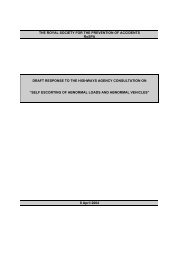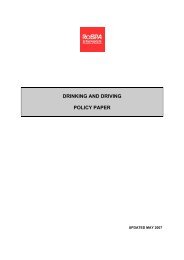RoSPA Young Drivers at Work Report
RoSPA Young Drivers at Work Report
RoSPA Young Drivers at Work Report
You also want an ePaper? Increase the reach of your titles
YUMPU automatically turns print PDFs into web optimized ePapers that Google loves.
Chapter 3<br />
This response was corrobor<strong>at</strong>ed by the fact th<strong>at</strong> their<br />
organis<strong>at</strong>ion did not undertake any driver assessments or<br />
driver training for staff members. Their managing road risk<br />
policy was limited to checking employees’ driving licences<br />
and insurance cover. The organis<strong>at</strong>ion also did not consider<br />
young drivers to be <strong>at</strong> any gre<strong>at</strong>er risk on the road than<br />
more experienced drivers. Consequently, their young<br />
drivers were expected to make the same type of journeys<br />
as their more experienced colleagues.<br />
Nearly adequ<strong>at</strong>e<br />
Three respondents (6%) reported th<strong>at</strong> they felt the current<br />
system of training and testing was ‘just about’ adequ<strong>at</strong>e.<br />
They only raised one or two areas where they felt the<br />
current system could be improved. It is worth noting th<strong>at</strong><br />
in two of the three cases, young employees only drove on<br />
work sites with maximum speed limits of 15 or 20mph.<br />
A further two respondents (4%) initially indic<strong>at</strong>ed th<strong>at</strong> they<br />
regarded the current system as adequ<strong>at</strong>e. They said th<strong>at</strong><br />
they thought the driving test was ‘OK’ and ‘fairly good’.<br />
However further questions revealed th<strong>at</strong> these companies<br />
conducted routine in-house driver assessments as a result<br />
of which some employees receiving neg<strong>at</strong>ive reports had<br />
been ‘grounded’ from driving.<br />
The two companies had also bought in advanced driver<br />
training, from external agents, for their regular drivers.<br />
This suggests either:<br />
“Nowhere near good enough, it needs to be a<br />
lot, lot better. ”<br />
(Small business owner)<br />
“Woefully inadequ<strong>at</strong>e. If there’s a poor score put it<br />
down <strong>at</strong> the lowest score and I mean th<strong>at</strong>. ”<br />
(Director, priv<strong>at</strong>e company)<br />
3.2 How does <strong>at</strong>-work driving differ from<br />
other driving?<br />
Any vari<strong>at</strong>ion between the type of driving young drivers<br />
are expected to do for work and ‘non’ work-rel<strong>at</strong>ed driving<br />
may give an insight into why employers think young<br />
drivers are unprepared. It may also give some indic<strong>at</strong>ion of<br />
wh<strong>at</strong> should be addressed in any changes to the learning<br />
to drive and testing regime or wh<strong>at</strong> should be included in<br />
any post test training.<br />
Table 2 shows question 2.1 of the questionnaire ‘How<br />
adequ<strong>at</strong>ely do you feel the current driving test prepares<br />
young drivers for driving for work? cross-tabul<strong>at</strong>ed with<br />
question 1.6 ‘Wh<strong>at</strong> sorts of jobs involving driving do your<br />
younger drivers undertake?’<br />
Table 2: Adequacy of the current test <strong>at</strong> preparing young<br />
drivers for <strong>at</strong>-work driving shown by journey<br />
type (N = 407).<br />
Completely Quite Not Not Non- Total<br />
very <strong>at</strong> all response<br />
●<br />
●<br />
Th<strong>at</strong> although they regarded the current system of<br />
learning to drive and testing as ‘adequ<strong>at</strong>e’, they did not<br />
rely on it to assure th<strong>at</strong> their drivers were of a safe and<br />
reliable standard<br />
Or they felt the need to raise their drivers’ standards<br />
beyond those required for driving test purposes<br />
Sales visits 10 21 32 19 2 84<br />
Deliveries to and<br />
from customers 10 37 42 42 8 139<br />
Service visits<br />
to customers 14 55 90 37 10 206<br />
Carrying<br />
passengers 8 44 52 19 13 136<br />
Not adequ<strong>at</strong>e<br />
The remaining 41 respondents (87%) unreservedly regarded<br />
the current system of training and testing as ‘inadequ<strong>at</strong>e’<br />
for <strong>at</strong>-work driving. There were some very strongly-held<br />
opinions within this group:<br />
“Wholly inadequ<strong>at</strong>e for modern driving, a 35<br />
minute test and a video game does not prepare<br />
anyone for driving 30,000 miles a year. ”<br />
(Director, priv<strong>at</strong>e company)<br />
Other 10 35 55 23 8 131<br />
Total 27 110 163 80 27 407<br />
Out of the 131 ‘other’ responses for Q1.6, 51% of respondents<br />
said the driving job their young colleagues were doing was<br />
driving between work sites. This figure includes travel to<br />
external meetings and training events. 6% of young drivers<br />
within the ‘other’ c<strong>at</strong>egory were carrying out short ad hoc<br />
trips for work.<br />
“I don’t think th<strong>at</strong> driving instruction or testing in<br />
this country is <strong>at</strong> all adequ<strong>at</strong>e. ”<br />
(Manager, priv<strong>at</strong>e company)<br />
8 <strong>Young</strong> <strong>Drivers</strong> <strong>at</strong> <strong>Work</strong> <strong>Report</strong>
















